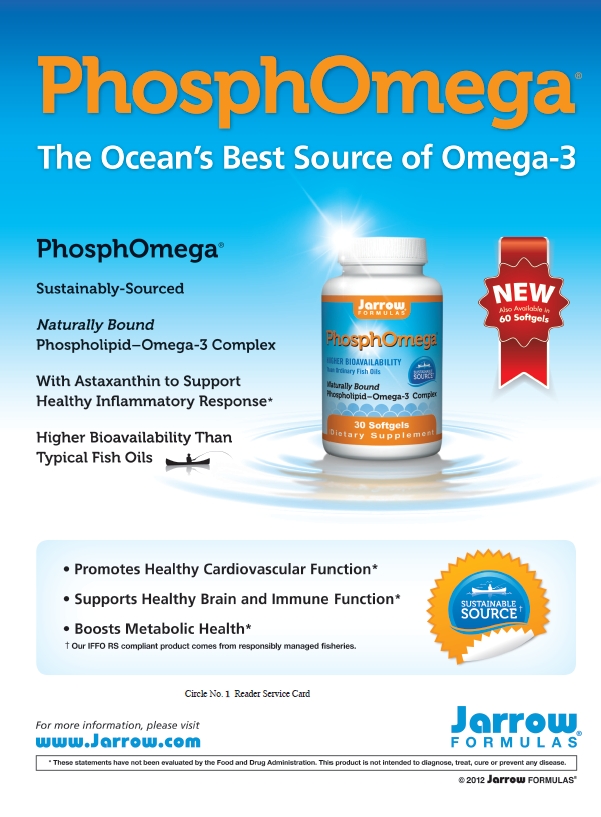They understand more than ever what their nutrition needs are, yet they can’t always easily find the time, or spend the money, to bridge the gap from knowing what’s healthy to practicing it in their diet. Because of these factors, consumers keep turning to food products with healthy ingredients added in as bonus nutrition. Certain functional ingredients are especially popular already, while others are climbing the ladder of consumer awareness.
This has all meant steady and noticeable growth for the functional foods category at large. One market research report notes that the food additives sector is not immune to economic issues, and therefore forecasts relatively modest growth overall (1). But, what we won’t see flag is consumer demand for additives including vitamins and minerals, omega-3 fatty acids, probiotics and a host of others. Those that supply these ingredients are ready and eager to provide manufacturers with what they need to satisfy consumer wants.
Though a newly intense focus on science and credibility, stemming from the values of supplies themselves and from the regulatory climate, provides a check against unbridled growth, it will serve to make the market stronger in the end. Consumers are observant of this extra effort, and they appreciate it because they reap the rewards. Says Patrick Luchsinger, nutrition marketing manager, Corn Products International, Inc., Westchester, IL, “The inclusion and highlighting of functional ingredients convey to the consumer that the brand is more contemporary, and conscious about consumers’ well-being.”
Food Well-Fortified
Though many functional food ingredients have a wide appeal, the market is still segmented by what each individual ingredient brings to the table in terms of versatility and stability in the end product. Also, consumers’ health situations and nutritional needs and deficits are always different, and so many ingredients are best suited for use by certain subpopulations. Luckily for us, the expert insight that follows represents the many corners of the diverse food fortification market.
Omega-3 fatty acids seem to have cropped up in every imaginable type of food product (even ice cream) in recent years. They therefore warrant an early mention, and it will suffice to note that this success came as a result of tireless innovation and collaboration between food manufacturers and omega-3 suppliers, on the subject of how to incorporate such a hot ingredient into foods while maintaining safety, stability and taste.
Another factor in the growth of the category of functional foods is the popularity of functional beverages, especially those derived from superfruits like acai. A report on the overall market potential of functional foods, citing beverages as a driver, puts the dollar mark for sales at $130 billion by 2015 (2).
Compared with exotic products like acai, the prospect of common foods like oat bran may elicit less consumer excitement. But many grains, long acknowledged for their heart-healthy qualities, have seen a niche carved out for them in the functional foods business. “It has been long known that oat bran and barley bran, and ancient grains such as amaranth, quinoa, millet, spelt and chia are healthy foods, but in recent years a new technology has allowed these natural products to be more easily used in a wide range of formulations,” says Hartley Pond, vice president of technical sales for VDF/FutureCeuticals, Momence, IL. This revolution was made possible through an advancement with roots at the U.S. Department of Agriculture (USDA) called trim technology. Pond details his company’s patented method for rendering grains into a powdered form suitable for inclusion in a range of food products, including liquids.
 Pond notes that consumers are desperately in search of natural ways to stay heart-healthy. The development of the “trim” shearing process allows the beta glucans in soluble fiber to be concentrated when derived from grains. These compounds have been linked to cholesterol reduction and a lowered risk of cardiovascular disease, according to Pond.
Pond notes that consumers are desperately in search of natural ways to stay heart-healthy. The development of the “trim” shearing process allows the beta glucans in soluble fiber to be concentrated when derived from grains. These compounds have been linked to cholesterol reduction and a lowered risk of cardiovascular disease, according to Pond.
This means, he says for example, that products can now vie for a U.S. Food and Drug Administration (FDA)-allowable heart health claim, at the 0.75 g/serving level for oat soluble fiber. “Additionally,” Pond says, “the shearing process dramatically improves the rheological profile of oat bran, providing a creamy ‘fat mimetic’ texture making an ideal ingredient for smoothies, meal replacements and nutritional baked goods.”
The effect of introducing such products to consumers is to better their health. “Barley bran that has been mechanically sheared offers not only the functionality for potentially reducing cholesterol, but also modulation of blood glucose and insulin levels,” Pond says. A recent study by the USDA into a patented ingredient (BarleyTrim from FutureCeuticals) found it to reduce plasma glucose and insulin response in overweight men.
Another functional food category that has “been around forever,” as put by Mike Bush, vice president of business development, Ganeden Biotech, Mayfield Heights, OH, is probiotics. Though their stock is steadily rising already, there remains some catching up to do on this side of the pond, when it comes to appreciating these beneficial microscopic organisms and their role in food. “Europe and Asia are far ahead of the United States in awareness of the benefits of probiotics,” says Bush, adding that he is starting to see that awareness rise, due in part to the promotional work of probiotics companies. The key to this growth, he offers, is the promotion of and investment in branded, recognized strains of probiotic bacteria.
The benefits of probiotics, long confined to yogurt for most consumers, are making their presence felt in new territory lately. Bush gives the example of the sports nutrition market. His company was involved in the launch last fall of a probiotic-infused protein powder, and Bush calls it one of the more interesting projects they’ve worked on.
“People typically don’t think of probiotic fortification when it comes to sports and fitness type products, in particular with straight-out protein,” he says. Probiotics are, nevertheless, suited for consumption by athletes and those training hard, since digestive distress can often accompany adding protein to the diet in the amounts these individuals do. “There have been lots of studies published that show that performance athletes have suppressed immune systems due to overtraining, or whatever the case may be. If you’re working out hard, you should be taking a probiotic anyway, so why not get it all in the same place?” Bush adds.
The probiotic market has also catered to the so-called “lifestyle consumer,” who may for instance want to add probiotics to their diet, but don’t want to add a new habit or routine to their day. Allowing people to incorporate probiotics seamlessly into their meals (Bush gives the example of probiotic-fortified orange juice) has been a boon for consumers and product makers. Probiotic oatmeals are on the horizon, Bush says, and seem a natural fit since oatmeal-eaters are often already health conscious. The stability of certain probiotic strains through the process of making oatmeal comes from their spore-forming nature, which makes them heat stable.
so-called “lifestyle consumer,” who may for instance want to add probiotics to their diet, but don’t want to add a new habit or routine to their day. Allowing people to incorporate probiotics seamlessly into their meals (Bush gives the example of probiotic-fortified orange juice) has been a boon for consumers and product makers. Probiotic oatmeals are on the horizon, Bush says, and seem a natural fit since oatmeal-eaters are often already health conscious. The stability of certain probiotic strains through the process of making oatmeal comes from their spore-forming nature, which makes them heat stable.
Prebiotic substances foster a welcoming environment for probiotic bacteria and promote their growth. “Prebiotic fibers are poised for growth similar to that experienced by omega-3 fatty acids,” says Luchsinger. Consumers, he explains, are aware of prebiotic fiber’s scientifically recognized digestive, bone and immune health benefits.
Prebiotics like his company’s NutraFlora, said to support the growth of probiotics in the colon and improve calcium absorption, are increasingly added to food products and called out on product packaging. Whether this manifests itself by using the logo of a branded ingredient on finished product packaging, or with nutrient content claims such as “good source of fiber,” Luchsinger said prebiotics are now starting to deliver “nutrition by addition.”
Fiber of another sort can be delivered in the form of agave inulin. This soluble dietary fiber, as opposed to insoluble fibers that are sometimes easier to come by, falls under the heading of a functional food for its capacity to serve as roughage and its links to other health benefits. Jim Morano, Ph.D., technical affiliate of Suzanne’s Specialties, New Brunswick, NJ, describes the versatility of agave inulin.
First and foremost, its incorporation into more food products gives consumer diets something they often lack. “The average consumer in the United States is grossly deficient in their consumption of fiber, per day,” he says. Secondly, when it isn’t hydrolyzed (as done with agave nectar), agave inulin can provide a level of viscosity useful for incorporation into beverages. There is the potential to include needed dietary fiber in products like smoothies and yogurts.
An interesting development for agave inulin as a functional ingredient might be the ability to lower its molecular weight, according to Morano. This would, in turn, lower the viscosity of the ingredient, allowing for more of it to be worked into solid food products such as energy or cereal bars, where too much of a high-molecular weight, high-viscosity substance can make for a gummy mouth feel.
 Sweeteners with healthy upsides are an interesting segment of the functional ingredients market. As sweeteners, they are integral to the taste and mouth-feel of food products, and therefore serve an indispensable practical purpose. But as traditional synthetic sweeteners are phased out over health concerns and price woes, natural sweeteners such as stevia offer a welcome alternative to product formulators and a new, healthier choice for consumers. “Unlike sugar and artificial sweeteners that provide zero benefit to the human body other than a sweet taste, stevia provides numerous health and healing benefits in addition to its sweet taste, as well as causing no harm or ill effects,” says James May, president and CEO of Wisdom Natural Brands, Gilbert, AZ.
Sweeteners with healthy upsides are an interesting segment of the functional ingredients market. As sweeteners, they are integral to the taste and mouth-feel of food products, and therefore serve an indispensable practical purpose. But as traditional synthetic sweeteners are phased out over health concerns and price woes, natural sweeteners such as stevia offer a welcome alternative to product formulators and a new, healthier choice for consumers. “Unlike sugar and artificial sweeteners that provide zero benefit to the human body other than a sweet taste, stevia provides numerous health and healing benefits in addition to its sweet taste, as well as causing no harm or ill effects,” says James May, president and CEO of Wisdom Natural Brands, Gilbert, AZ.
He goes on to say that unlike sucrose from sugar cane or sugar beet, the glycosides of stevia contain zero calories, zero carbohydrates and carry a glycemic index of zero. For this reason, they do not negatively influence fat creation or storage. This quality makes stevia a valued aid in maintaining a desired weight, according to May.
Stevia’s glycosides can also inhibit the production of oral bacteria that cause gum disease and cavities, May says. He also says the mountain of scientific evidence regarding stevia’s safety (he estimates 1,500 studies) also point to blood sugar, blood pressure and insulin-regulating effects for stevia (3). For further evidence of benefits, he points to recent research from Belgium on the free-radical scavenging ability of stevia glycosides within the body. This perhaps explains the benefits that oral stevia intake is said to have for certain diseases that involve oxidative stress. There is, then, a favorable argument for including stevia in any food product that needs a little sweetening. “Stevia glycosides can be used to sweeten any food or beverage. The uses are as varied as one’s imagination,” says May.
The group of consumers that will benefit from insulin regulation unfortunately includes many, and chromium is established for this purpose. Including a stable and effective chromium in food products is a natural extension of this application. Paul Dijkstra, CEO of InterHealth Nutraceuticals, Benicia, CA, describes a branded chromium dinicocysteinate (Zychrome from his company) that is getting an entrée into the blood sugar and diabetic foods market.
Clinical research, Dijkstra says, positions this ingredient as a superior form of chromium, improving insulin function more than chromium picolinate. With regard to its introduction to the food market, Dijkstra foresees success, since he believes that ingredients affecting insulin and insulin resistance will start to rise in popularity as the public’s understanding of the role of insulin increases.
Limitations and Regulations
Finding safe, stable and desirable ways to incorporate functional ingredients into food is a tough business. There are always hurdles to be met with, but breakthroughs in innovation let suppliers and manufacturers leap over them to create new products.
Forging ahead with new uses for stevia has been a trying task, but the returns on that investment have been coming in. This table top sweetener has now, for instance, been made a key ingredient in an array of liquid products containing stevia glycosides on offer from May’s company. “Children, teens and adults report that when they add a few drops of stevia flavors like Root Beer, Cola, Grape or Lemon to sparkling water, it tastes exactly like the sodas of the same flavors, resulting in a delightful drink that contains absolutely nothing harmful,” he says.
Like with any other functional ingredient, there are pitfalls. “The intensely sweet stevia glycosides can also be used as an ingredient in any food or beverage; however, food processors must experiment to assure they use the right amount,” says May. He explains that utilizing too little may not impart the sweet profile formulators are after, and using too much can make for a bitter aftertaste.
Inserting heart-healthy grains into food has also required some problem solving. Of their incorporation in food, Pond says, “Until recently, ancient grains such as millet, quinoa, chia, spelt, durhum and buckwheat have proven problematic due to their gritty mouth feel.” But the mechanical shearing already described allows for these grains to take on a smooth, creamy texture. Couple that with their high protein and amino acid content, and they become a welcome element in meal replacements, sports nutrition beverages and baked goods, Pond explains.
One general rule in working with a functional ingredient is to make sure it has a minimal impact on the final taste, odor and color of the food product, according to Dijkstra, who states, “Our goal is to provide ingredients that can be incorporated into foods or beverages in such a way that the consumer can enjoy all the benefits that the product provides without any negative effects.”
Dijkstra goes on to argue that most often with functional ingredients, where there’s a will there’s a way, as long as the parties involved know what they’re getting into. “There is really no such thing as a bad vehicle for nutrient delivery. What is important is knowing how to incorporate nutrients in a given vehicle, considering stability and organoleptics through the entire process,” he says. For suppliers, it’s also often a matter of seizing the opportunity. Because insoluble fiber can create a sawdust-like taste in food products, especially when too much is used, Morano sees an opening for soluble fibers like agave inulin to make headway, particularly in drink formats.
Once the capacity to produce finished food products using functional ingredients is in place, there remains the quandary of regulatory oversight, regarding what is safe and just what claims can be made about the health benefits of a given ingredient. Functional foods taken as a group find themselves in a sort of limbo as far as regulation is concerned. As the definition of the nebulous concept of functional foods continues to develop, many of the same rules that apply to dietary supplements make their presence felt in this market as well.
One plus for the grains that make use of Trim Line technology, for example and according to Pond, is that they are generally recognized as safe (GRAS), and therefore there is no regulatory concern for companies designing new functional food formulations with them included. Increased regulatory activity has food companies preferring to research develop and bring to market foods that only contain GRAS ingredients, Luchsinger believes. “Self-affirmed GRAS status is a step in the right direction for functional ingredients, but GRAS approved is preferred by manufacturers and consumers alike,” he says.
Because of the promising GRAS status of probiotic offerings, Bush sees good things in store for his sector. But, fly-by-night marketers shouldn’t get ahead of themselves, because it may not cut it anymore to simply sell any old acidophilus. “We feel very optimistic. We feel like there’s a bright future ahead for not only us but for the entire industry. It’s an especially exciting time for companies that promote strain specific benefits. We don’t think it’s a great time to be in the ‘selling generic strains with no clinical data’ business,” Bush says.
Market watch. The direction that innovation and new product offerings have taken in functional foods is one thing; their effective marketing to consumers is another. Are shoppers more moved to buy products that address general health categories on the label, like ”heart health” and “digestive health,” or are the ingredients themselves the attraction? “Star ingredients, backed by well-designed clinical studies and a fair amount of consumer and retailer outreach, will help drive consumer interest,” Dijkstra believes.
But the question remains an open one, and part of the answer for product marketers may lie in covering all their bases. “We’re all doing our best to make sure that consumers can equate the term probiotic with the benefits themselves,” says Bush. In the U.S. market today, he says, health claims are very important to consumers. Whether consumer preference is to see these claims laid out, or if the term “probiotic,” for example, is good enough remains to be seen. Bush says, “We’re actually just in the process of finishing up a good-sized consumer survey where that question was asked.”
Is the consumer thirst for “bonus nutrition” a trend with staying power? Bush thinks so, and cites the common sense perspective that if a traditionally presented food is good, then a fortified food is better, so why not get more nutrition from the same source? How much more consumers are willing to pay is another matter. Bush notes that there seems to be a about a 20–25% difference in price between a fortified and non-fortified product in today’s marketplace, but it will be interesting to see what the market will ultimately bear. WF
References
1. “Mixed Outlook for the Global Additives Market Says Leatherhead Food Research,” www.leatherheadfood.com/mixed-outlook-for-the-global-additives-market-says-leatherhead-food-research, accessed Feb. 28, 2012.
2. PRWeb, “Global Functional Foods and Drinks Mhttp://www.prweb.com/releases/functional_foods/functional_drinks/prweb4688424.htmarket…” http://www.prweb.com/releases/functional_foods/functional_drinks/prweb4688424.htm, accessed Feb. 28, 2012.
3. B. Geeraert, et al., “Stevioside Inhibits Atherosclerosis by Improving Insulin Signaling and Antioxidant Defense in Obese Insulin-Resistant Mice,” Int. J. Obes. (Lond). 34(3), 569-77 (2010).
Published in WholeFoods Magazine, April 2012









